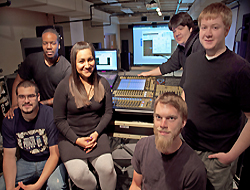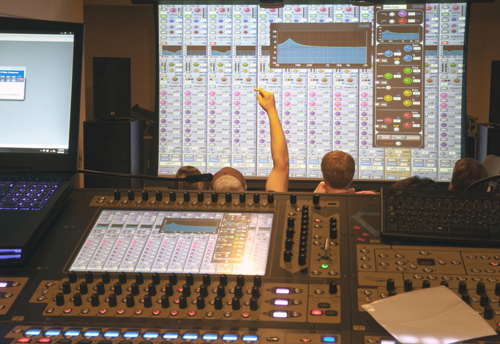
Solving Problems
Yeah, O.K., so we now have a “smart” classroom.
Which means exactly nothing without method, which has finally combined with the hardware to produce a situation that aligns nicely with the changes in the industry and the academy.
It goes like this – first, a problem is presented, like, say, fixing the sound of the Aerosmith SACD remasters.
This particular day, Audiocore is off limits – we are training the input channel and group parametrics on the SD8. SD8 touchscreen sent to the 12-footer.
Audiocore sent to house right 100-inch. The cut is fired into front L/R for evaluation. Students are herded into the sweet spot. (Why do they always hide in the corner?) Instructor throws down spot analysis – fix Tyler’s vocal (500 Hz and related environs), find non-existent snare drum (not so easy), and generate kick/bass separation while improving impact low-pass 125 Hz.
Ground rules – students use hand signals (and sometimes speak) to communicate parametric adjustments to the TA operating the hardware from front of house riser. As an adjustment is signaled, the TA grabs the appropriate control, and students see the change real-time on the 12-footer while they hear the adjustment in the rig.
Instructor is allowed to kibbutz from the sidelines, occasionally stopping things for a mini-lecture to make a specific point, but the kids must work as a team to fix the stated problems. On XTA/Audiocore days, that gets sent to the 12-footer and the SD8 touchscreen is routed to the 100-inch.
On monitor class days, we position the wedges and caller so that the SD8 1/3-octave is up on the 100-inch, which he and all the kids face, so that as the 1/3 filters move up and down in response to his requests, they both see and hear the changes.
Getting Ahead
This is not better or worse than sitting on a road-case back when, watching those Brits pulling a monitor tweak in some dank basement on Clark Street. It is different – faster, more organized, denser, more pleasant (sometimes).
There will always be the site/based observational paradigm – as soon as the kids get their first post-college jobs they will get a bellyful of that – but this year’s model provides a hell of a head start.
Now if they could just do something about those digital console layers…
Jack Alexander is an associate professor and director of the Live and Installed Sound Program in the Department of Audio Arts & Acoustics at Columbia College Chicago.

